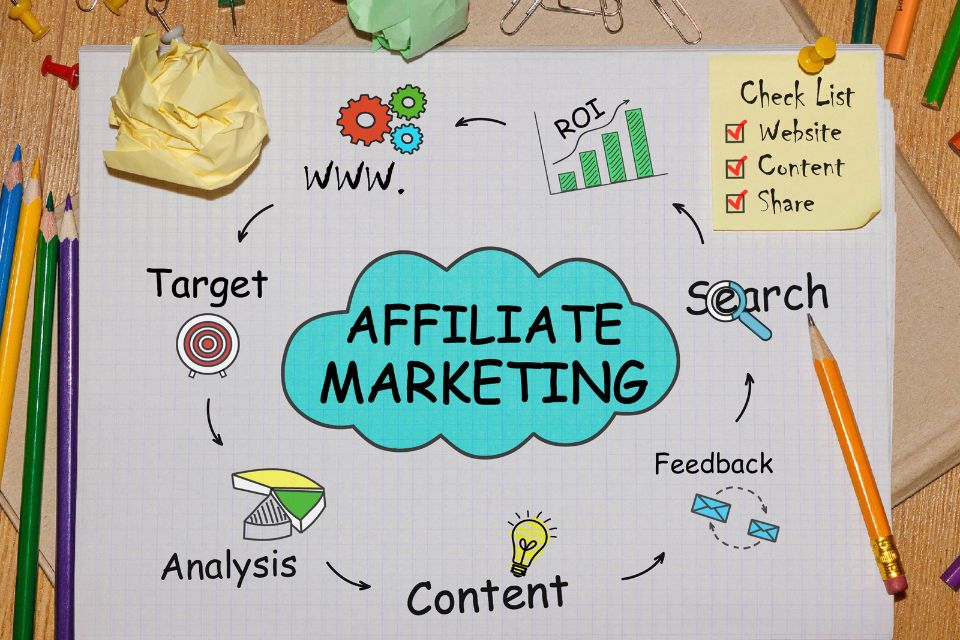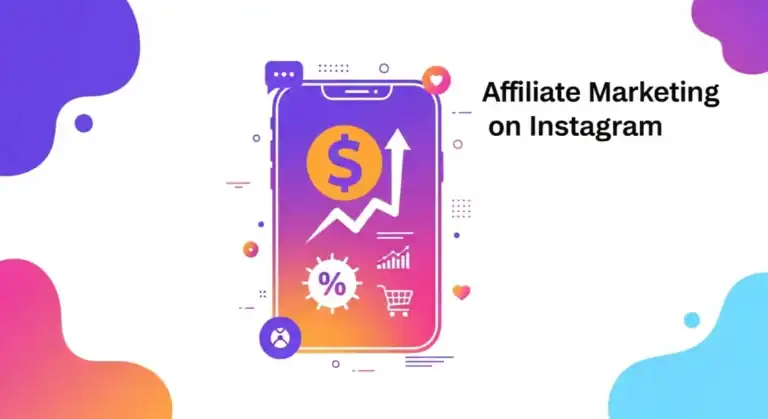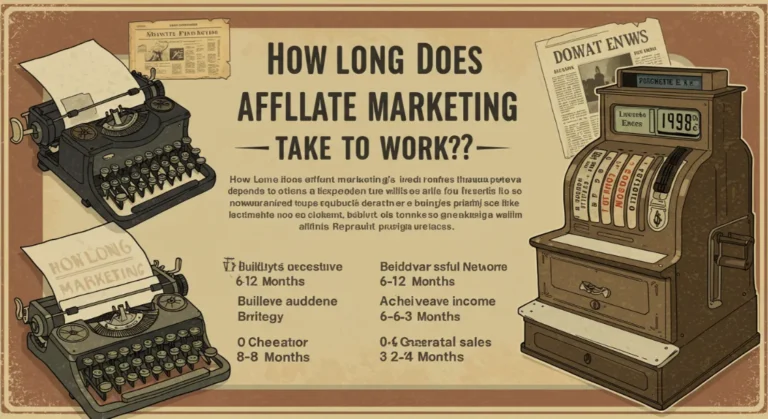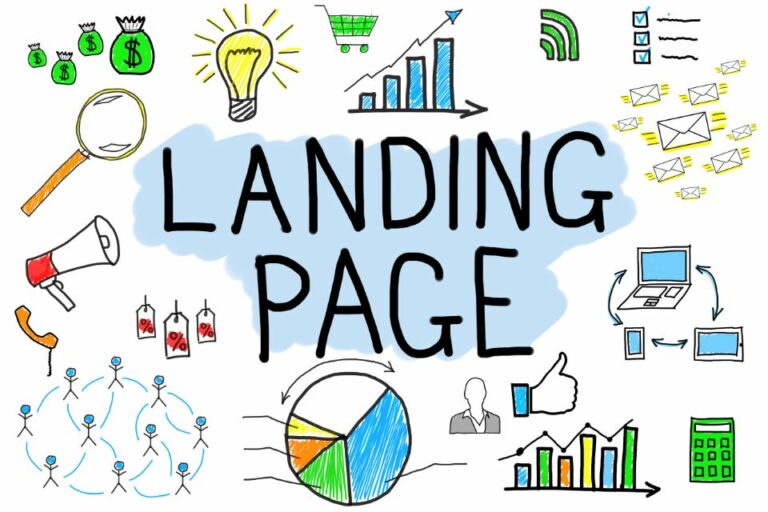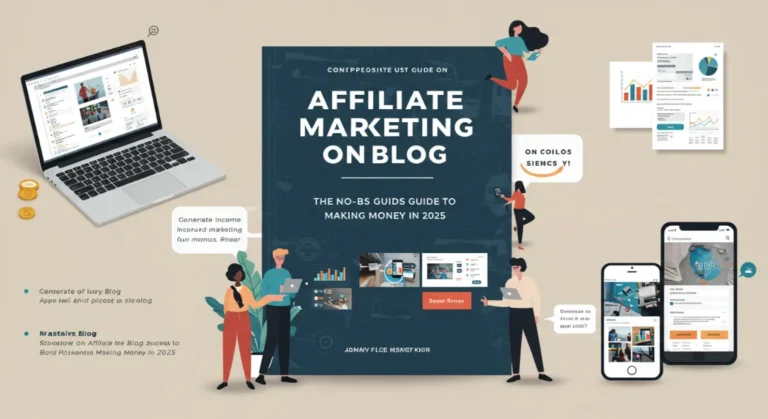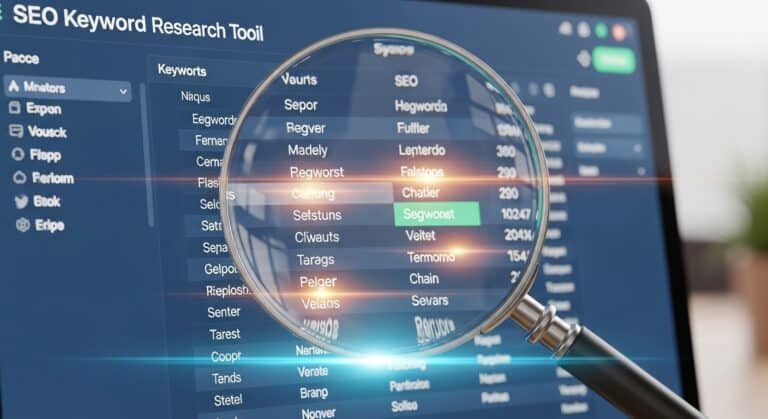Ultimate 2026 Guide: Affiliate Marketing Without a Website in 7 Steps
AFFILIATE MARKETING STRATEGIES 2026: HOW TO BOOST YOUR SEO & INCOME PROTOCOL: ACTIVE
ID: REF-2025-E1888Conclusions built strictly upon verifiable data and validated research.
Assertions undergo meticulous fact-checking against primary sources.
Delivering clear, impartial, and practical insights for application.
How do you promote affiliate products without a website? You focus on two things: building a targeted audience and presenting them with a high-converting offer. This guide shows you the exact system to do it.
🔑 Key Takeaways
- Shift Your Model: Your platform (like a website) is not your asset. Your audience is.
- Master the Loop: Find a micro-niche, craft an irresistible offer, and dominate one traffic channel.
- Start with Free Traffic: Use platforms like TikTok, YouTube Shorts, or Facebook Groups to build trust before spending a dollar.
- Build an Email List: Use free tools like ConvertKit or Google Forms to capture leads without a website.
- Avoid the #1 Mistake: Do not spray generic affiliate links. Provide value first, then recommend.
- Scale with Paid Ads: Once you have a winning offer, use Facebook Ads or TikTok Ads to amplify your best content.
The Real Problem Isn’t Your Effort, It’s Your Model
You work hard but see no results. The reason is a broken model. The old playbook tells you to build a complex website, master SEO, and create endless content before making your first sale. That path is slow and expensive.
The new model is about leverage. Focus on the inputs that deliver 80% of the results: targeted traffic and a high-quality offer. You can generate commissions by mastering platforms like Instagram Reels or building an email list with Mailchimp. The website is optional.
The Core Principle: Own Your Audience, Not Your Platform
Success comes from doing the right things with overwhelming force. Stop obsessing over inputs (like website design). Start obsessing over outputs: an engaged audience and direct sales.
Effort vs. Leverage: My Personal Operating System for Affiliates
| Metric | The Grinder (99% of People) | The Strategist (My Approach) |
|---|---|---|
| Focus | Inputs (Website, SEO, complex tools) | Outputs (Audience, Offer, Conversion) |
| My Take | This is the slow, painful path to burnout and debt. I’ve been there, trust me. | This is the only way to achieve exponential growth and win long-term with affiliate marketing without a website. |
| Barrier to Entry | High (Tech skills, capital, time) | Low (Smartphone, social account) |
| Scalability | Requires more infrastructure | Scales with audience growth and ad spend |
| Speed to Income | Slow, often months or years | Fast, often weeks or days |
This video solidified the mindset shift for me. Watch it to understand why a fancy site isn’t the starting point.
My ‘Audience-First Leverage Loop’: Your Blueprint for Asymmetric Returns
This is my three-part framework for promoting affiliate products without a website. It’s designed for maximum leverage and minimum waste.
Part 1: Discover Your Micro-Niche & Obsess Over Their Pain
Your greatest leverage is a specific, underserved audience. Don’t target “weight loss.” Target “busy single mothers over 40 struggling with energy levels.” The narrower your focus, the easier it is to connect and convert.
My Action Step for You: The ‘Customer Avatar Deep Dive’
Spend one day researching. Go to Reddit communities, Facebook Groups, and YouTube comments where your ideal customer is. Document their exact language, frustrations, and dreams. Create a detailed profile. This research informs all your future content.
My Customer Avatar Deep Dive Worksheet
| Category | Questions to Answer | Your Target Customer’s Response (Be Specific) |
|---|---|---|
| Demographics | Age, Location, Income, Job, Family Status | E.g., 38-45, suburban, $60-80k, marketing manager, 2 kids |
| Pains | What keeps them up at night? What frustrations do they vocalize? | E.g., Low energy, no time for self-care, feeling overwhelmed, guilt about kids |
| Desires | What do they truly want? What are their aspirations? | E.g., More energy, better sleep, simple routines, feeling in control, self-worth |
| Current Solutions | What have they tried? Why did it fail? | E.g., Fad diets (too restrictive), gym memberships (no time), other supplements (no results) |
| Objections | What are their hesitations about new solutions? | E.g., ‘Too expensive,’ ‘Doesn’t work for me,’ ‘No time to implement’ |
| Where They Hang Out | Specific forums, groups, social media platforms | E.g., Facebook groups for working moms, TikTok, Pinterest, specific subreddits |
This deep dive makes your audience engagement automatic.
Part 2: Craft Irresistible Offers & Shorten The Path to Conversion
Don’t just share a link. Offer a transformation. Select high-converting offers from networks like ShareASale or ClickBank that solve the pain you identified.
Create a micro-funnel without a website. Use a free landing page from ConvertKit or a Linktree in your social bio to capture emails. Deliver value first—a free guide or a quick tip—then introduce the affiliate product.
My Action Step for You: The ‘Value Stack & Micro-Funnel’ Design
1. Find an affiliate product that genuinely solves a problem.
2. Create a compelling hook (e.g., “Free 5-Day Energy Checklist”).
3. Use a free tool like Google Forms to capture emails.
4. Deliver the value, then present the offer.
This is funnel optimization in its simplest, most effective form.
💡 My Pro Tip: Quantity leads to quality. Your 100th attempt at a sales message will be far better than your first. Get to 100 fast by testing on platforms like Twitter (X) or in niche Facebook Groups.
Part 3: Dominate One Free Traffic Channel, Then Scale with Paid Traffic
Pick one platform where your audience lives. Crush it. For most, this means a social media marketing strategy on TikTok, Instagram Reels, or YouTube Shorts.
My Action Step for You: The ‘Content Tsunami Strategy’
Choose one platform. Commit to creating daily, value-packed content that addresses your audience’s pain. Serve, don’t sell. Create short product review videos or tutorials. Guide viewers to your free lead magnet.
Once you get consistent organic conversions, then consider paid traffic strategies. Use Facebook Ads or TikTok Ads to boost your top-performing content directly to your lead capture form.
My Top Free Traffic Channels for Affiliates (No Website Needed)
| Channel | My Strategy & Why It Works | Content Examples | Internal Link Guidance |
|---|---|---|---|
| TikTok/Instagram Reels | Short-form, value-packed videos. High virality potential. Perfect for demonstrating product benefits. | ‘3 Hacks to Boost Energy,’ ‘Product Demo: Does X Work?’, ‘Behind the Scenes of My Routine’ | How to Use Social Media for Affiliate Marketing |
| YouTube Shorts | Similar to TikTok but leverages YouTube’s search power for evergreen content. Ideal for mini-tutorials. | ‘Quick Review of X Product,’ ‘How-To: Solve Y Problem in 60 Secs’ | How to Use YouTube for Affiliate Marketing |
| Facebook Groups | Engage with targeted communities. Provide value, answer questions, then subtly introduce solutions. | ‘My experience with X product,’ ‘Asked for advice on Y problem, here’s what worked.’ | Affiliate Marketing on Instagram (principles apply) |
| Email Marketing | The ultimate owned audience. Use a simple landing page creator (free options available) to build your list. | Value-packed newsletters, exclusive deals, mini-courses, targeted product recommendations. | Email List for Affiliate Marketing |
| Visual search engine. Great for ‘how-to’ and ‘inspiration’ content. Direct links in pins. | Infographics, product collages, ‘X ideas for Y problem’ with product links. | Affiliate Marketing on Pinterest |
The goal is to provide so much value that people ask for your recommendations.
What The ‘Gurus’ Get Wrong About Promoting Affiliate Products Without A Website
Here are the three biggest myths in affiliate marketing without a website, and the reality.
Affiliate Marketing Myths Debunked: My Reality Check
| The Lie I See Everywhere | The Hard Truth I Learned (My Experience) | Your New Action Plan |
|---|---|---|
| ‘You need to be on every platform.’ | You need to dominate one platform. Focus beats breadth. Period. Trying to do it all is a recipe for mediocrity and burnout. I tried it and failed. | My challenge to you: Pick one channel from the table above and go all-in for 12 months. Master it. |
| ‘It takes a long time to see results.’ | It takes a long time if your feedback loops are long. Shorten them. If you’re not getting direct feedback on your offers, you’re guessing. | Test small, learn fast. I run weekly experiments, not yearly plans. Send a few DMs, make a few posts, track engagement daily. |
| ‘You need a big budget for ads.’ | You need a better offer and a better understanding of your audience. A truly great offer is its own marketing, especially when paired with strong content creation for affiliates. | Spend one full day improving your offer’s presentation and targeting. It’s the highest ROI activity there is. Check your niche selection for affiliates – are you truly serving a specific need? |
| ‘Direct linking is always bad.’ | Direct linking can be highly effective *if* your traffic source allows it and your offer is compelling. The issue is usually poor targeting or a weak offer, not the method itself. | Evaluate your traffic source rules. For platforms like Pinterest or email lists, direct linking (with disclosure) can be efficient. But ensure you understand the rules to avoid getting banned. |
| ‘You need your own products to truly win.’ | While having your own product offers ultimate control, mastering affiliate marketing without a website with high-converting offers first teaches you invaluable sales and marketing skills that directly translate. | Focus on promoting high-converting offers as an affiliate first. Learn how to sell other people’s stuff effectively. The skills are transferable and low-risk. |
❓ Frequently Asked Questions
Can I really make significant money without a website?
Yes. A website is just one platform. Your real assets are your audience and your ability to connect them with solutions. In 2026, most successful affiliates start on social media or email before ever building a site.
What are the best platforms to start with?
TikTok/Instagram Reels for short-form video, YouTube for long-form authority, and niche Facebook Groups. For direct ownership, build an email list using a free tool like ConvertKit from day one.
How do I build an email list without a website?
Use free landing page builders (ConvertKit, Carrd) or a Linktree in your social bio. Offer a valuable lead magnet (checklist, template). Promote it on your chosen social channel to capture emails directly.
Is paid advertising feasible for direct linking?
Yes, but test carefully. Use Facebook Ads or Google Ads to send traffic directly to a high-converting merchant page or your lead capture form. Start with a small budget and scale only what’s profitable.
What products work best with this approach?
Digital products (online courses, SaaS tools like Canva Pro) and high-value physical goods that solve a specific problem. Choose offers with strong sales pages and good commissions from networks like ShareASale.
Conclusion
The playbook is complete. The model flips the script: you don’t need a website; you need an audience and an offer. Your path is the Audience-First Leverage Loop: find a micro-niche, craft a compelling offer, and dominate one free traffic channel.
Your next step is execution. Today, choose your micro-niche. Tomorrow, create your first piece of value-packed content for that audience on one platform. Use a free tool to set up a lead capture form.
Stop analyzing. Start doing. Your first commission is waiting on the other side of focused action.
References
- How I Do Affiliate Marketing Without a Website and Make Money – Medium
- Best Affiliate Programs For Beginners Without a Website (2026) – GetResponse
- How to Do Affiliate Marketing Without a Website in 2026 – Voluum Blog
- How to do affiliate marketing without a website? – Zoho
- The Ultimate Guide to Affiliate Marketing – HubSpot
- 2026 Affiliate Marketing Trends Report – impact.com
{ "@context": "https://schema.org", "@graph": [ { "@type": "Organization", "@id": "https://affiliatemarketingforsuccess.com#organization", "name": "Affiliate Marketing for Success", "url": "https://affiliatemarketingforsuccess.com", "logo": { "@type": "ImageObject", "@id": "https://affiliatemarketingforsuccess.com#logo", "url": "https://affiliatemarketingforsuccess.com/wp-content/uploads/2023/03/cropped-Affiliate-Marketing-for-Success-Logo-Edited.png?lm=6666FEE0", "width": 600, "height": 60 } }, { "@type": "Person", "@id": "https://affiliatemarketingforsuccess.com/author/alexios-papaioannou-2/#person", "name": "Alexios Papaioannou", "url": "https://affiliatemarketingforsuccess.com/author/alexios-papaioannou-2/", "description": "Expert content creator specializing in https://affiliatemarketingforsuccess.com/affiliate-marketing/how-to-promote-affiliate-products-without-a-website/", "knowsAbout": [ "https://affiliatemarketingforsuccess.com/affiliate-marketing/how-to-promote-affiliate-products-without-a-website/" ] }, { "@type": "WebSite", "@id": "https://affiliatemarketingforsuccess.com#website", "url": "https://affiliatemarketingforsuccess.com", "name": "Affiliate Marketing for Success", "publisher": { "@id": "https://affiliatemarketingforsuccess.com#organization" }, "potentialAction": { "@type": "SearchAction", "target": { "@type": "EntryPoint", "urlTemplate": "https://affiliatemarketingforsuccess.com/?s={search_term_string}" }, "query-input": "required name=search_term_string" } }, { "@type": "BlogPosting", "@id": "https://affiliatemarketingforsuccess.com/httpsaffiliatemarketingforsuccesscomaffiliate-marketinghow-to-promote-affiliate-products-without-a-website#article", "mainEntityOfPage": { "@type": "WebPage", "@id": "https://affiliatemarketingforsuccess.com/httpsaffiliatemarketingforsuccesscomaffiliate-marketinghow-to-promote-affiliate-products-without-a-website" }, "headline": "https://affiliatemarketingforsuccess.com/affiliate-marketing/how-to-promote-affiliate-products-without-a-website/", "description": "Comprehensive guide on https://affiliatemarketingforsuccess.com/affiliate-marketing/how-to-promote-affiliate-products-without-a-website/.", "about": { "@type": "Thing", "name": "https://affiliatemarketingforsuccess.com/affiliate-marketing/how-to-promote-affiliate-products-without-a-website/", "sameAs": "https://en.wikipedia.org/wiki/https://affiliatemarketingforsuccess.com/affiliate-marketing/how-to-promote-affiliate-products-without-a-website/" }, "mentions": [], "image": [], "datePublished": "2025-12-06T15:04:24.275Z", "dateModified": "2025-12-06T15:04:24.275Z", "author": { "@type": "Person", "@id": "https://affiliatemarketingforsuccess.com/author/alexios-papaioannou-2/#person", "name": "Alexios Papaioannou", "url": "https://affiliatemarketingforsuccess.com/author/alexios-papaioannou-2/", "description": "Expert content creator specializing in https://affiliatemarketingforsuccess.com/affiliate-marketing/how-to-promote-affiliate-products-without-a-website/", "knowsAbout": [ "https://affiliatemarketingforsuccess.com/affiliate-marketing/how-to-promote-affiliate-products-without-a-website/" ] }, "publisher": { "@type": "Organization", "@id": "https://affiliatemarketingforsuccess.com#organization", "name": "Affiliate Marketing for Success", "url": "https://affiliatemarketingforsuccess.com", "logo": { "@type": "ImageObject", "@id": "https://affiliatemarketingforsuccess.com#logo", "url": "https://affiliatemarketingforsuccess.com/wp-content/uploads/2023/03/cropped-Affiliate-Marketing-for-Success-Logo-Edited.png?lm=6666FEE0", "width": 600, "height": 60 } }, "keywords": "https://affiliatemarketingforsuccess.com/affiliate-marketing/how-to-promote-affiliate-products-without-a-website/", "articleSection": "https://affiliatemarketingforsuccess.com/affiliate-marketing/how-to-promote-affiliate-products-without-a-website/", "wordCount": 2, "timeRequired": "PT1M", "inLanguage": "en-US", "isAccessibleForFree": true, "speakable": { "@type": "SpeakableSpecification", "cssSelector": [ "h1", "h2", "h3" ] } }, { "@type": "BreadcrumbList", "@id": "https://affiliatemarketingforsuccess.com/httpsaffiliatemarketingforsuccesscomaffiliate-marketinghow-to-promote-affiliate-products-without-a-website#breadcrumb", "itemListElement": [ { "@type": "ListItem", "position": 1, "name": "Home", "item": "https://affiliatemarketingforsuccess.com" }, { "@type": "ListItem", "position": 2, "name": "https://affiliatemarketingforsuccess.com/affiliate-marketing/how-to-promote-affiliate-products-without-a-website/", "item": "https://affiliatemarketingforsuccess.com/category/https://affiliatemarketingforsuccess.com/affiliate-marketing/how-to-promote-affiliate-products-without-a-website/" }, { "@type": "ListItem", "position": 3, "name": "https://affiliatemarketingforsuccess.com/affiliate-marketing/how-to-promote-affiliate-products-without-a-website/", "item": "https://affiliatemarketingforsuccess.com/httpsaffiliatemarketingforsuccesscomaffiliate-marketinghow-to-promote-affiliate-products-without-a-website" } ]
Alexios Papaioannou
I’m Alexios Papaioannou, an experienced affiliate marketer and content creator. With a decade of expertise, I excel in crafting engaging blog posts to boost your brand. My love for running fuels my creativity. Let’s create exceptional content together!

